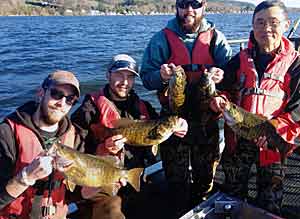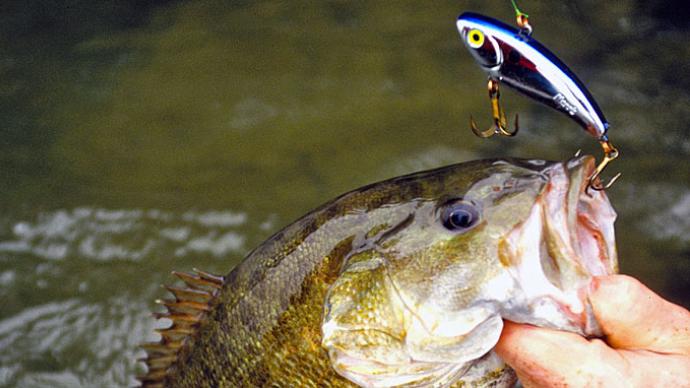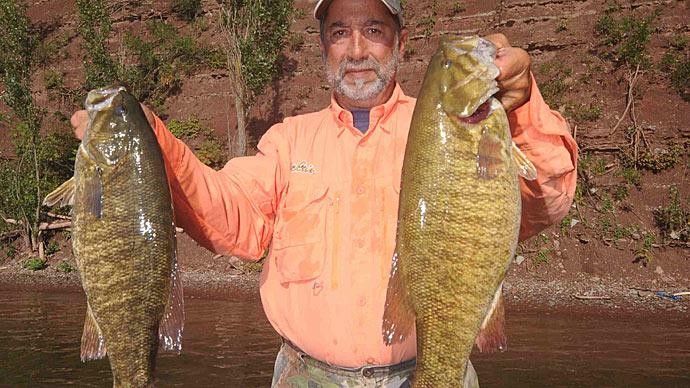
I love to learn new things. My wife, Christine, might disagree with this statement, but... sometimes I like to be proven wrong. Often we fall into a trap of having hard and fast rules that we tend to follow. Just when I think I understand the exact science of how aquatic systems work, along comes an example that proves me wrong. Rule broken. So much of what we do as stewards of the ponderverse (yes, I created a word) is almost an art.
And so goes the case of how Cornwell views the interaction between largemouth and smallmouth bass.
Many of my stories start with a problem. The phone rings and the person on the line states the problem: "Mark, we think we have harmed our fishery by manipulating the water level of our lake." Hmmm.. .here we go...
This lake's owners have been manipulating the water level to freeze the bottom to kill invasive amounts of Eurasian watermilfoil (Myriophvl-lum spicatum). Sometimes this means drawing the water level down as much as eight feet in late fall to expose the entire natural littoral zone to a deep, killing frost. They have been quite effective at controlling invasive milfoil in this way. Milfoil is still in the lake but is under control with the present management strategy of drawdown, freeze-in-winter, then refill in the spring. This drawdown strategy for milfoil control has been made possible by installing a very nice water control structure in the dam of this 400-acre upstate New York private lake. The benefits of this strategy allow the homeowner's association to avoid the use of expensive chemicals and homeowners docks and piers are kept free of excessive ice damage. Win-win.
The lake managers had the goal of refilling the lake by Memorial Day, to facilitate recreational use of the lake on that busy holiday and for the rest of summer. A few years ago, Mother Nature threw them a curve ball with a rare spring drought that extended through Memorial Day. The lake did not refill. Water was not up to the docks and the normal littoral zone was high and dry in the spring. A typical natural littoral zone would have:
- Shallow, relatively stable water level.
- Sunlight penetration to the sediments.
- Green plants.
- Inorganic and organic material deposition
At some point during the drawdown all above were affected. So back at the fish cave, the investigation begins. Have they damaged their fishery as they suspect? We hooked up the electrofishing boat and headed out to the lake to conduct a fisheries survey. We launched the boat on a humid, close feeling, early fall night. As darkness approached, the generator was cranked up, the lights popped on, and fish rolled into the waiting nets of my agile college students, eagerly netting on the bow of the boat. Into the live well came the fish. For every largemouth brought onboard there were at least three smallmouths—and some very impressive ones to boot! And, even a few large tiger muskies! Nice. Not quite what we'd expect, not quite normal—but, nice.
The educational component of this project? For me, it began a disruption of conventional thinking on interactions between smallmouth and largemouth bass. In almost every lake I have studied where largemouth and smallmouth exist, largemouth win at some level. Every time.

What does that mean? Well, I have witnessed smallmouth extirpation in at least three local lakes where largemouth were introduced on top of smallmouth. The lakes were smaller (20-40 acres) and shallow (<8ft). There were abundant golden shiners and smallmouth in these waters. Someone introduced largemouth in an unauthorized stocking and POOF! Within 10 years all smallmouth were G-O-N-E, gone, baby gone. Largemouth win!
In more diverse, larger lakes, with a variety of littoral habitats, my experience is that largemouth and smallmouth co-exist a little better. For example, run an electrofishing boat around most large New York lakes and you will find good populations of both largemouth and smallmouth. Which is more abundant? Usually largemouth. In deep, rocky lakes with an abbreviated weedy littoral zone, largemouth and smallmouth catch rates are about equal. In shallower, weedier lakes, largemouth can outnumber smallmouth 10 to 1 or more. Again, largemouth win. In virtually every system present, my experience has led me to form the opinion that largemouth will outcompete other fishes. Largemouth are the dominant predator in virtually any system in which they are present. Often their success is at the detriment of other predators in the system. In other words, when largemouth bass are in your lake they are top dawg.

What we observed in this lake was that smallmouth was more abundant than largemouth. Smallmouth had a higher catch per hour of electrofishing and had a larger average size than the largemouth. Catchable, stock size smallmouth (>7") outnumbered stock size largemouth (>8") by 5 to 1. There were five times more catchable smallmouth than largemouth. Conventional wisdom broken! Advantage smallmouth!
Now, the next question.
Why? Consultants are brought into situations like this—to study and then give their opinion on what they observe. In other words, this group of lake owners hired me to give an educated guess. Can I definitively tell why smallmouths have an advantage in what I would expect to be a largemouth dominated lake? No, but I can make an educated guess.
Water level manipulation has somehow disrupted the life cycle of largemouth bass. Most likely, during the period of the long, deep draw¬down and resulting slow refill during the spring drought, largemouth did not get off a successful spawn. Or, habitat that was available at the time of the spawn was not of sufficient quality to be successful. It's possible that nests were established, and then were covered up by additional feet of water later in the spring, causing the nests to be in a less than ideal location and consequently, they failed. In any event, my gut tells me that the water level manipulation in this lake gives the advantage to the smallmouth. And yes, I know that smallmouth need to spawn also.

Another example occurs in a highly unstable reservoir owned by the New York Power Authority in upstate New York. There are two reservoirs that go up and down 40 feet a day, meeting the needs of a pumped storage power generation plant. The littoral zone is massively disrupted in this system. There are no rooted aquatic plants, no attached algae, and no deposition of organic sediment. Essentially, there is no littoral, except for a few isolated ponds near the back of each reservoir. In these systems, smallmouth outnumber largemouth 250 to 1. Wow! There is almost no habitat for largemouth to spawn. Yet, somehow smallmouth pull it off!
Smallmouth win!
It may all be as simple as this. Werner (2004) explains that largemouth bass are fish of quiet weedy water. Largemouth bass prefer shallow, weedy bays whereas smallmouth prefers deeper, rocky habitats. Largemouth tend to choose spawning nests in shallower, weedier habitat than do smallmouth. Smallmouth may spawn in water 2-20ft. deep while largemouth typically spawn in water l-4ft. deep (Smith, 1984). Consequently, even when largemouth and smallmouth are found in the same lake, they rarely occur together (Werner 2004). None of this should come as a surprise. So, what's your point Cornwell? In systems where the littoral zone is disturbed, smallmouth appear to do better than largemouth, even if that disturbance is only temporary, as in the case of the once-a-year draw down used for milfoil management. In managing their milfoil problem, these nice folks unintentionally created a situation giving smallmouth the advantage. They made the habitat less weedy and gave the advantage to the smallmouth that can spawn earlier, in deeper rocky habitat. And depending on your perspective, this might be a nice problem to have.
Can you use this to your advantage? My current thinking is—YES. Many folks call me and want nothing but smallmouth in a lake dominated by largemouth. They want more smallies. Largemouth are ubiquitous, they are pretty much everywhere. Many pond owners want something unique—a lake with plentiful smallmouth. Water level manipulation to disrupt largemouth bass spawning may be part of the plan. This may be an avenue worth exploring in the future management of your smallmouth-largemouth pond. If I could manipulate the water level in Cornwell pond, I would try to swing the pendulum toward—advantage smallmouth!
Smith, C. L. 1985. The Inland Fishes of New York State. The New York State Department of Environmental Conservation. Albany. Werner (2004). Freshwater Fishes of the Northeastern Unites States, A Field Guide. Syracuse University Press, Syracuse, NY 13244.
Reprinted with permission from Pond Boss Magazine



